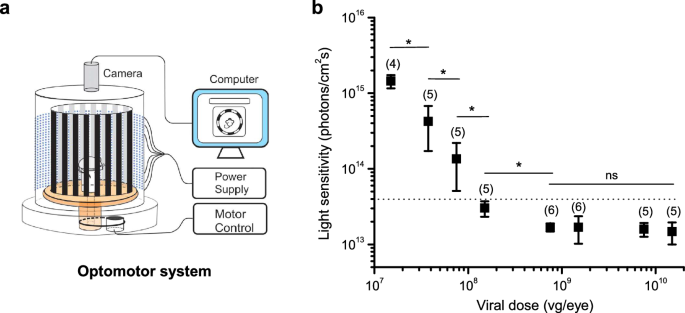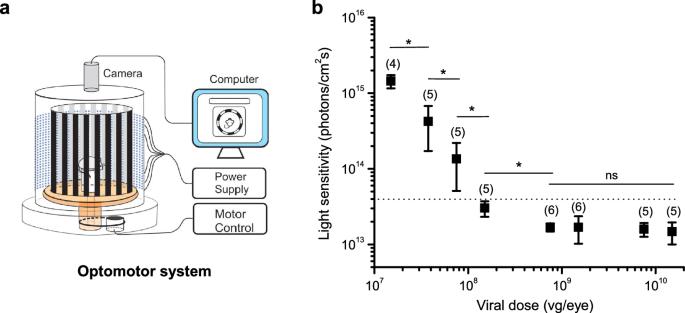视网膜神经节细胞中 AAV 的剂量依赖性转导效率和光遗传学视力恢复的功能效果。
IF 4.5
3区 医学
Q1 BIOCHEMISTRY & MOLECULAR BIOLOGY
引用次数: 0
摘要
光遗传学是让感光器变性后失明的人恢复视力的一种很有前景的方法。在动物模型中,通过 AAV 介导的光敏蛋白(尤其是通道视蛋白)输送到视网膜神经节细胞中恢复视力的能力已得到广泛证实。在临床应用中,需要了解病毒剂量依赖性的功能疗效。在本研究中,我们利用三重基因敲除盲鼠模型和高光敏性通道视网膜神经节蛋白变体,通过视运动行为测定,评估了病毒通过视网膜神经节细胞表达恢复视力的剂量依赖性。我们的结果表明,在病毒剂量为 108 vg 时,光敏感性和视敏度的恢复均达到峰值水平。随着剂量的增加,转导效率持续上升,而蛋白表达量在剂量约为109 vg时达到峰值,剂量越大,表达量越低。此外,视网膜胶质细胞病变和炎症反应在剂量为 ~109 vg 时开始明显增加,在剂量为 ~1010 时观察到明显增加。这些结果为临床研究的病毒剂量设计提供了宝贵的启示。本文章由计算机程序翻译,如有差异,请以英文原文为准。


AAV dose-dependent transduction efficiency in retinal ganglion cells and functional efficacy of optogenetic vision restoration
Optogenetics is a promising approach for restoring vision to the blind after photoreceptor degeneration. The ability to restore vision through AAV-mediated delivery of light-sensitive proteins, especially channelrhodopsins, into retinal ganglion cells has been extensively demonstrated in animal models. For clinical application, knowledge of viral dose-dependent functional efficacy is desired. In this study, using a triple-knockout blind mouse model and a highly light-sensitive channelrhodopsin variant, we evaluated viral dose-dependent vision restoration through retinal ganglion cell expression by using optomotor behavioral assays. Our results show that both the restored light sensitivity and visual acuity reached peak levels at a medial viral dose of 108 vg. With increasing dose, transduction efficiency continued to increase while protein expression peaked at the dose of ~109 vg and declined at higher doses. Also, a significant increase in retinal gliosis and inflammatory responses started at the dose of ~109 vg, and a marked increase was observed at the dose of ~1010. These results provide valuable insights into viral dose design for clinical studies.
求助全文
通过发布文献求助,成功后即可免费获取论文全文。
去求助
来源期刊

Gene Therapy
医学-生化与分子生物学
CiteScore
9.70
自引率
2.00%
发文量
67
审稿时长
4-8 weeks
期刊介绍:
Gene Therapy covers both the research and clinical applications of novel therapeutic techniques based on a genetic component. Over the last few decades, significant advances in technologies ranging from identifying novel genetic targets that cause disease through to clinical studies, which show therapeutic benefit, have elevated this multidisciplinary field to the forefront of modern medicine.
 求助内容:
求助内容: 应助结果提醒方式:
应助结果提醒方式:


